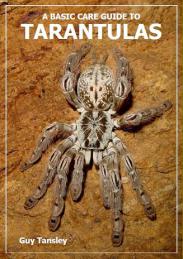
Although having five species in the Stromatopelma Karsch, 1881 genus,
only one is available in the hobby, S. calceatum.
S.
calceatum (Fabricius, 1793) - West Africa
Relatively easy to maintain in captivity, S. calceatum is a stunning spider. The
overall colour is tawny yellow/brown with a subdued starburst pattern on the carapace and symmetrically spotted and striped abdomen. The legs are covered with long setae and banded and spotted with
black similar to Poecilotheria. The males are somewhat slender in comparison but
have delicate hairs on the legs giving this species it's common name (feather leg). No tibial hooks are present but the male has a well developed scopulae brush on the metatarsus of the first pair of
legs. During mating this is used to wedge between the females chelicerae and palps to both support her weight and give him some degree of protection. Click here for a more detailed description on the use of the male scopulae brush during mating. Females can
live in excess of ten years and although not that easy to breed in captivity, captive bred spiderlings should be available (a fixed egg sac is produced in this species). Like all African scrubland
species, the substrate can be allowed to dry out periodically but humidity should be increased during moulting and eggsac production etc. No collection is complete without a specimen or two
of S. calceatum. Relatively common and
widespread throughout savannah and scrub areas of equatorial West Africa from Guinea to Cameroon, S.
calceatum lives in tube webs at the base of palm fronds as much as forty feet above the ground so a typical arboreal set-up is ideal using slabs of cork bark
for the spider to build its retreat. Females will live in excess of 10 years and can reach up to 15cms in legspan.

